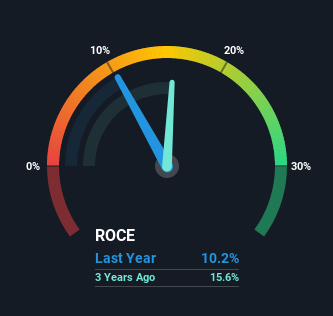- Chile
- /
- Electric Utilities
- /
- SNSE:ENELAM
Enel Américas (SNSE:ENELAM) Is Reinvesting At Lower Rates Of Return

What trends should we look for it we want to identify stocks that can multiply in value over the long term? Ideally, a business will show two trends; firstly a growing return on capital employed (ROCE) and secondly, an increasing amount of capital employed. Put simply, these types of businesses are compounding machines, meaning they are continually reinvesting their earnings at ever-higher rates of return. Although, when we looked at Enel Américas (SNSE:ENELAM), it didn't seem to tick all of these boxes.
Return On Capital Employed (ROCE): What is it?
If you haven't worked with ROCE before, it measures the 'return' (pre-tax profit) a company generates from capital employed in its business. The formula for this calculation on Enel Américas is:
Return on Capital Employed = Earnings Before Interest and Tax (EBIT) ÷ (Total Assets - Current Liabilities)
0.10 = US$1.9b ÷ (US$25b - US$6.7b) (Based on the trailing twelve months to March 2021).
So, Enel Américas has an ROCE of 10%. That's a relatively normal return on capital, and it's around the 8.6% generated by the Electric Utilities industry.
See our latest analysis for Enel Américas

In the above chart we have measured Enel Américas' prior ROCE against its prior performance, but the future is arguably more important. If you'd like, you can check out the forecasts from the analysts covering Enel Américas here for free.
How Are Returns Trending?
In terms of Enel Américas' historical ROCE movements, the trend isn't fantastic. Around five years ago the returns on capital were 16%, but since then they've fallen to 10%. Given the business is employing more capital while revenue has slipped, this is a bit concerning. This could mean that the business is losing its competitive advantage or market share, because while more money is being put into ventures, it's actually producing a lower return - "less bang for their buck" per se.
Our Take On Enel Américas' ROCE
In summary, we're somewhat concerned by Enel Américas' diminishing returns on increasing amounts of capital. In spite of that, the stock has delivered a 7.5% return to shareholders who held over the last five years. Regardless, we don't like the trends as they are and if they persist, we think you might find better investments elsewhere.
Enel Américas does have some risks though, and we've spotted 4 warning signs for Enel Américas that you might be interested in.
While Enel Américas isn't earning the highest return, check out this free list of companies that are earning high returns on equity with solid balance sheets.
If you’re looking to trade a wide range of investments, open an account with the lowest-cost* platform trusted by professionals, Interactive Brokers. Their clients from over 200 countries and territories trade stocks, options, futures, forex, bonds and funds worldwide from a single integrated account. Promoted
Valuation is complex, but we're here to simplify it.
Discover if Enel Américas might be undervalued or overvalued with our detailed analysis, featuring fair value estimates, potential risks, dividends, insider trades, and its financial condition.
Access Free AnalysisThis article by Simply Wall St is general in nature. It does not constitute a recommendation to buy or sell any stock, and does not take account of your objectives, or your financial situation. We aim to bring you long-term focused analysis driven by fundamental data. Note that our analysis may not factor in the latest price-sensitive company announcements or qualitative material. Simply Wall St has no position in any stocks mentioned.
*Interactive Brokers Rated Lowest Cost Broker by StockBrokers.com Annual Online Review 2020
Have feedback on this article? Concerned about the content? Get in touch with us directly. Alternatively, email editorial-team (at) simplywallst.com.
About SNSE:ENELAM
Enel Américas
Generates, transmits, and distributes electricity in Brazil, Colombia, Central America, Argentina, and Peru.
Proven track record with moderate growth potential.
Similar Companies
Market Insights
Community Narratives



